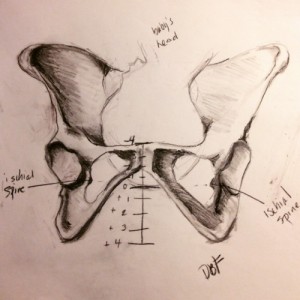Navigation
Watch most motion pictures or TV exhibits that present a hospital setting the place a lady is giving beginning and feedback like “how dilated is she?” or “Oh, you might be 10 cm, let’s begin pushing!” are being thrown round. So it’s no marvel that many individuals affiliate labor progress with one figuring out factor- cervical dilation. Nonetheless, there’s one other key aspect to assist resolve when to start out the precise birthing of the baby- station!
What Is Station and Why Does It Matter?
Station refers back to the child’s place in relation to the ischial spines of the birthing particular person’s pelvis. The ischial spines are small bony protrusions that may be felt throughout a vaginal examination to evaluate the infant’s descent. (Please resist the urge to test this your self!)
- If the infant’s head has not but descended into the pelvis, it’s measured in destructive numbers from -4 to -1.
- As soon as the top is aligned with the ischial spines, it’s at 0 station.
- Because the child strikes additional down, it’s measured in optimistic numbers from +1 to +4, with +4 indicating crowning.
Understanding the infant’s station may also help decide the perfect time to start out pushing, somewhat than relying solely on dilation.

The Fetal Ejection Reflex, Ferguson Reflex and Medicated Births
Some folks expertise an uncontrollable urge to push—one pal described it as “vomiting out of her vagina”. This highly effective, involuntary physiological response is named fetal ejection reflex coined by French obstetrician Michel Odent.
The Ferguson reflex and the fetal ejection reflex are associated however distinct physiological responses throughout labor:
- Ferguson reflex: It is a neuroendocrine reflex triggered when the infant’s head presses on the cervix and vaginal partitions, stimulating stretch receptors. This strain alerts the discharge of oxytocin, which will increase the energy and frequency of contractions. It’s a part of the suggestions loop that helps labor progress.
- Fetal ejection reflex: it is a extra intense, involuntary expulsion of the infant, typically seen in undisturbed, unmedicated births. It’s characterised by highly effective, uncontrollable pushing efforts—typically described because the physique taking up. It’s much less about hormonal suggestions and extra a couple of sudden, instinctive motion to beginning the infant.
In brief, the Ferguson reflex helps ongoing labor, whereas the fetal ejection reflex is a dramatic, typically closing push to get the infant out.
When somebody has an epidural, each the Ferguson reflex and fetal ejection reflex might be considerably dampened and even utterly inhibited as a result of numbing impact on the decrease physique and pelvic nerves.
Why Laboring Down Can Make a Distinction
In lots of hospital settings, as soon as a mom begins pushing, she’s on the clock. Hospitals typically have a time restrict on pushing earlier than interventions reminiscent of a C-section are really useful for causes like “failure to progress.”
To assist keep away from pointless interventions, laboring down might be helpful. This implies permitting the uterus to proceed contracting and shifting the infant down passively earlier than actively pushing. Because the mom isn’t feeling the complete sensation of contractions in a medicated beginning, ready till the infant has reached a decrease station earlier than pushing can:
- Preserve vitality—no pointless early pushing.
- Cut back deadlines imposed by hospital insurance policies.
- Enhance the possibilities of a vaginal beginning by permitting the physique to do the work naturally earlier than partaking in energetic pushing.
Key Takeaways
- Dilation is just a part of the labor progress equation—station is equally necessary.
- The Ferguson reflex triggers an involuntary urge to push, however medicated births could not expertise this.
- Laboring down can stop exhaustion and cut back the probability of interventions like a C-section.
By understanding station, you can also make knowledgeable choices about when to push, saving vitality and probably avoiding pointless medical interventions. Information is energy! Glad birthing!
To study extra concerning the Prenatal Yoga Heart and the courses that we provide. Click on beneath to view our class schedule.
Useful sources!
Podcast: JAMA (The Journal of the American Medical Affiliation) Laboring Down Research; Yay or Nay?
Podcast: All Issues Cervix!
What’s the distinction between a strolling epidural and normal epidural?
Supply
http://being pregnant.about.com/cs/laborbasics/a/pushing.htm
Drawing credit- ME! (deb flashenberg)

